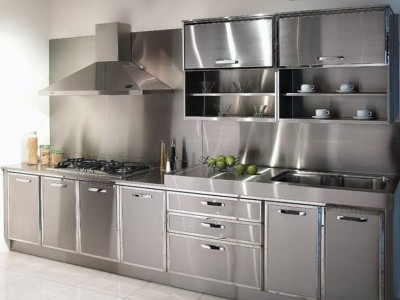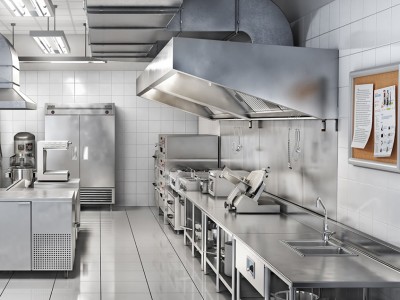- sub-total
- total
Commercial Work Table Buying Guide
Every busy kitchen needs available counter space for everything from food prep to equipment stations and space for active appliances. Buyers will have to figure out how much activity is going on in the kitchen, and what kinds of work processes have to be supported on a regular basis, while also providing for the odd overflow scenario. It can be a complex equation, with a lot of moving parts.
As you visualize your menu and how it will be prepared, you can start to get a handle on what kinds of kitchen work tables and how much counter space will be best for your restaurant. Here are some handy tips for choosing commercial stainless steel tables and other work table and countertop options.
Kitchen Work Table Sizing
First, you’ll want to calculate the square footage that you’ll need for restaurant prep tables and other countertop surfaces. You’ll also want to think about the height of these installations, where 36 inches is a common standard. For a better idea of how this works, spend some time in an active investigation in the kitchen. Watch where people go during a busy dinner service. Then plan accordingly.
Stainless Steel Kitchen Work Tables
When it comes to stainless steel kitchen work tables, you have some choices to make in terms of materials.
You’ll need to consider whether to get 304 grade stainless steel, which has 18% chromium and 8% percent nickel, and is more rust resistant than the corresponding 430 grade stainless steel with a bit less chromium and no nickel.
Both of these are easy to clean, and both of them will support busy restaurants, but the 304 grade is better for environments where gear is more likely to corrode.
Then you have your choices of gauge in stainless steel, where a smaller number means that your table is of tougher stuff, and therefore more sturdy.
14 gauge stainless steel is the top standard, and this is the stuff that busy chefs are looking for if they’ll need to be putting heavy impact on tables, for instance, pounding to tenderize meat or flatten out dough.
Alternately, you can go with 16 gauge or 18 gauge varieties that are slightly less durable than top-tier 14 gauge stainless steel, if you don’t need the performance, but want to save money instead.
Wood Top Kitchen Work Tables
You can also choose from a variety of models of commercial prep tables and kitchen work tables with wooden tops. Some of these that are often used for making bread, pastries and various baked goods are referred to as “baker’s blocks,” and others that are made to handle meats and a lot of knife work are called “butcher’s blocks.”
These wood top tables will also support your kitchen better with sturdy design and high quality build. For a butcher’s block, think about where your people will be keeping the knives, cleavers and other gear that help to break down meat supplies for the table.
Equipment Stands
Then, in addition to your primary workspaces, you want to have additional countertop areas for all of that impressive gear that helps your chefs to do sophisticated work with food. Whether it’s a fryer, a salamander or broiler, a mixer or a sous vide machine or anything else, you want your people to be able to easily access the gear and equipment in an ergonomic way, and in a way that saves time and effort in the kitchen. That’s where investing in equipment, and investing in space, makes sense.
Three Quick Questions for Commercial Prep Tables and Kitchen Work Tables
Here are three additional choices you may have to make when thinking about buying commercial prep tables or kitchen work tables for your kitchen.
- Rolling or stationary work tables – some of these work tables have casters, and others don’t. In some kitchens, you want to be able to move your countertop pieces around, in order to micromanage workflows to crank out a lot of food in a short time. However, in other kitchens, having casters on tables can be dangerous. Where there is going to be high heat or heavy equipment involved, casters can be a liability.
- Drawers or undershelves – you can also look at getting either drawers or undershelves built into your work tables and countertop spaces. In either case, this helps you to save space and keep appliances and accessories out of the way. The difference is that undershelves will allow your staff to reach in without opening and closing drawers, which can be advantageous in some setups, especially where you have to deal with small spaces.
- Sink or no sink – buyers can also order stainless steel countertops with sinks built-in. Again, this is going to depend on whether you need this accessory in a particular area or not.
Other Accessories and Features
Some of the other most common features for commercial work tables involve changes to top surfaces that help contain liquids or small bits of food.
A feature called backsplash can be useful where a countertop is up against the wall, or anywhere that stray liquids can be a concern. There is also something called a countertop edge that will similarly act to retain meat juices or anything else that escapes your chef’s eagle eye.
Straight or Rounded Corners
Here is another question to think about as you shop for wood or stainless steel kitchen work tables or other kinds of restaurant prep tables: do you want straight or rounded corners?
Stainless steel kitchen work tables come in both options. The answer has to do with safety in the kitchen.
Some kitchens can work just fine with square countertop edges. In other kitchens where there’s just not quite enough space, this can be dangerous because of various kinds of impact injuries. We’ve worked in kitchens ourselves, so we know that this happens. Busy line cooks and prep cooks and other people are running around trying to make their way through kitchen areas quickly. If you’ve seen someone bang themselves against a sharp countertop edge and take a timeout with an injury, you know that rounded edges can be valuable.










